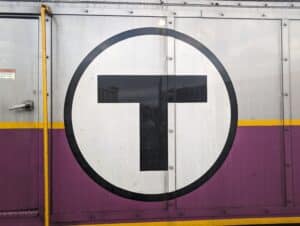
The MBTA's logo is seen on the side of an MBTA commuter rail locomotive in this file photo. Photo by James Sanna | Banker & Tradesman Staff
Ridership on the MBTA’s commuter rail system continues to rebound strongly, providing an interesting data point in the debate over whether Boston in the post-COVID era will face an office space glut that will make the city feel like a ghost town of empty buildings.
When COVID-19 hit in March 2020, ridership on commuter rail lines plummeted to less than 10 percent of what existed just a month before. As the pandemic dragged on, and remote work became a fixture, many wondered whether downtown Boston would survive.
But since then riders have slowly and steadily returned to the commuter rail system. In October, ridership hit more than 90 percent of pre-COVID levels, making it the most successful travel mode at the MBTA.
MBTA General Manager Phillip Eng said the commuter rail system may be a national leader. “The MBTA’s commuter rail ridership, if not the highest, is one of the highest across the nation,” Eng told the MBTA board last week.
Eng credited reliable, safe, and fairly frequent service for the turn of events. Those adjectives describing commuter rail service probably wouldn’t have been used seven to eight years ago, when the commuter rail system was struggling with on-time performance and state officials were thinking about rebidding the contract with Keolis Commuter Services, the private operator of the system.
The recent increase in commuter rail ridership is also a reflection of a return to the office – not the way it was before COVID but a new hybrid approach that seems to be centering on three days a week in the office.
Commuter rail officials say the highest ridership days are Tuesday, Wednesday, and Thursday. The highest ridership on individual days revolves around the work day, with peaks in the morning and evening, but those peaks are not as high and a bit more spread out over the day. There has also been a significant increase in weekend ridership – over 150 percent of pre-COVID levels since April. Overall, weekend ridership now represents 10 percent of the total, up from 5 percent pre-COVID.
James Aloisi, the former transportation secretary, said he believes the return to office jobs downtown is the key driver of commuter rail ridership.
Brian Kane, the executive director of the MBTA Advisory Board, which represents cities and towns in the T service area, said the rebound in commuter rail ridership is a very positive sign. “A lot of it has to do with employers encouraging workers to return to work and the terrible congestion they face,” he said of the jammed roadways facing those who choose to drive. “Commuter rail represents a good alternative.”
Kane said Boston will survive. “Those who wrote off downtown Boston are wrong,” he said.
Tamara Small, the CEO of NAIOP Massachusetts, which represents the state’s commercial real estate industry, said there’s no question there’s been a return to the office. “It’s safe to say we have seen Tuesday, Wednesday, and Thursday – people are going into the office,” she said. “People are tired of sitting in traffic. They’re seeing commuter rail as reliable and using it.”
But Small said the vacancy rate in downtown office buildings remains high and the hybrid work schedules will not change that. She said wrenching changes are in store for many buildings downtown and the city will have to adjust. She worries about the future, but acknowledges the situation is not as dire as some had feared. “It’s certainly not a ghost town by any means,” she said.
This article first appeared on CommonWealth Beacon and is being republished under a Creative Commons license.![]()





